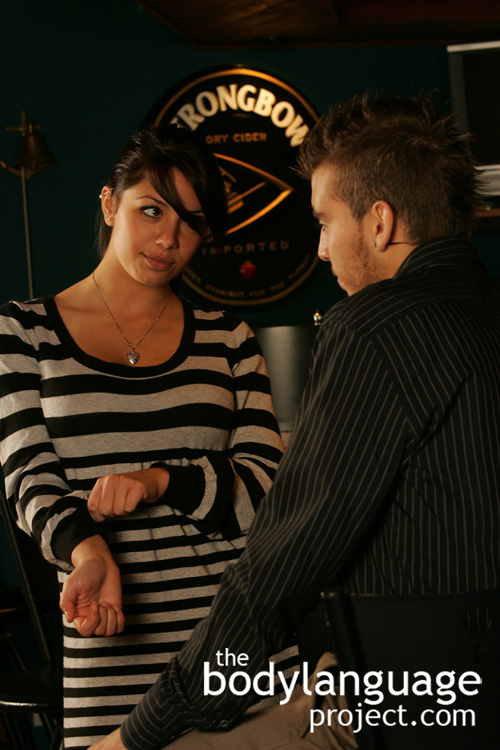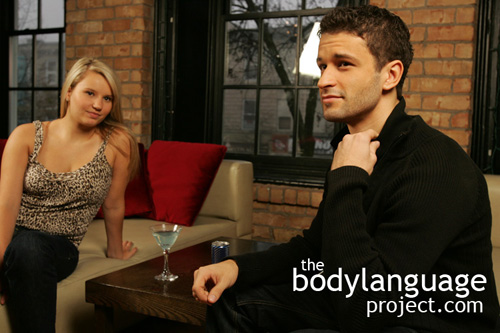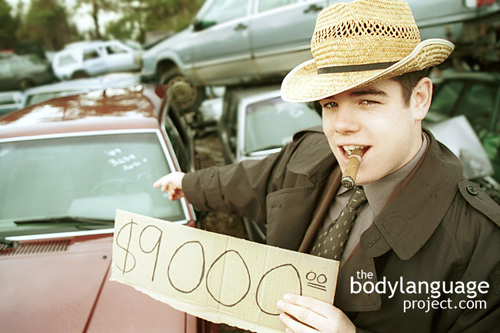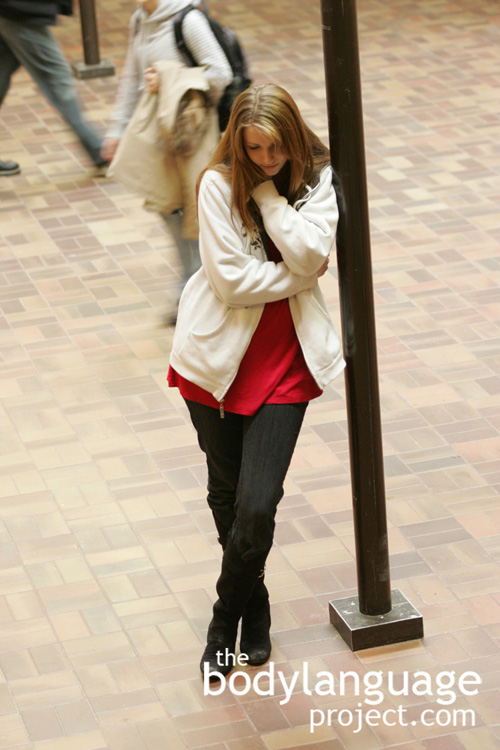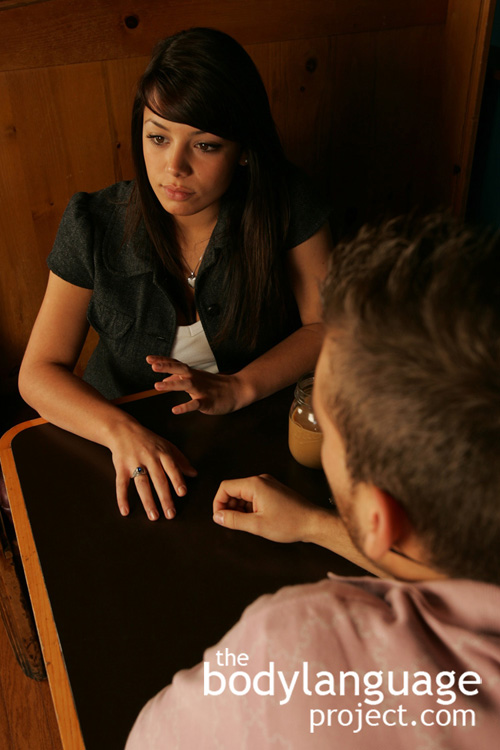Looking askance is a nonverbal cue that is done with the eyes and head in combination. It is done by tilting the head slightly to the side but stopping short of facing head on where the eyes roll the rest of the way forming a scowl. This face shows disapproval, distrust and suspicion. This cue is commonly associated with a disapproving mother type although this is usually in its exaggerated form. Other times the gesture happens quickly as if to say “You didn’t just say that, you better start backpedaling” or “I’ve heard what you said loud and clear, but I’m not buying what you’re selling.” Eye rolling, on the other hand spells disbelief as in “I can’t believe you just said this, you are a fool.”
Tag Archive for Cue
Looking Up Through The Forehead
by Chris Site Author • March 5, 2013 • 0 Comments
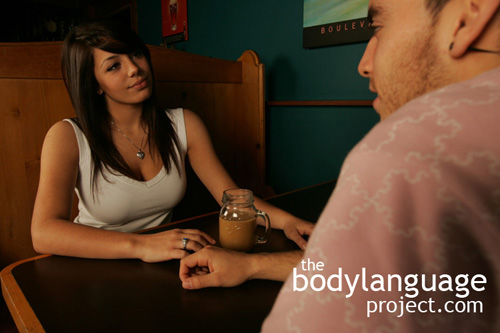
Head titled at 45 degrees coupled with the looking-up-through-the-forehead is a cue cluster of interest.
Looking up through the forehead is done by tilted the head at a forty-five degree angle and looking upwards. The posture is a reflection back into early childhood as children look up at us as seeking our approval or permission. Children might even add a big pouty lip as icing on the cake! This is a submissive posture and is included here in the chapter on eye language because the eyes play such an important role. When used by women it comes across as a “come-hither look.” It makes women appear more childlike and evokes protective feelings in men. The posture can be used to gain sympathy from others as well. Take for example, the asking of directions in a foreign environment. Adding a head tilt shows that you are no threat and also shows that you are in need of help. Subconsciously, people will see that you sincerely need and deserve the help, and will be more willing to assist you. It might even help reduce punishment should the context warrant it.
A study conducted in 2006 headed by Eva Krumhuber of the United Kingdom presented subjects with male and female computerized characters differing in types of smiles and head tilting. They found that a “slow onset smile”, a smile that gradually forms versus one that quickly flashes across the face, was not only more attractive, more trustworthy and more flirtatious but also less fake and less dominant. This held true for both men and women. The head tilt added an extra positive dimension as well. In the study they rated people as being even more attractive and trustworthy when they canted their head rather than kept it upright. The lesson here is that both men and women can use head tilt coupled with an honest slow growing smile to positively influence people.
The head tilt can also be helpful in creating cooperative arrangements or even favourable impressions, empathy and warmth, with just about everyone. Women are traditionally the most effective users of this gesture and for children, it comes naturally. Children are keen to use this ploy on us as they beg for sweets or for a sleep-over party or permission to join extra curricular activities. They pout their lips, tilt their head, and look up at us through sad eyes. If done properly, it makes us want to care for them and meet their needs but if overused, it makes us revolt, not unlike what we might see if overused by adults.
Eye Flashes, Eye Widening And Flashbulb Eyes
by Chris Site Author • March 5, 2013 • 0 Comments
The eye flash is similar to the eyebrow flash in that they both occur very quickly. In the case of the eye flash it lasts on average for only 0.75 seconds but is easily perceived and is quite obvious. The eye flash is a momentary widening of the eyelids during a conversation to reveal the sclera, or whites of the eyes, with no involvement of the eyelids. Humans are the only primates that have whites around their eyes whereas other ape’s eyes are completely dark. It has been theorized that the whites of the eyes evolved as a means of communication helping indicate eye direction.
The eyeflash when given by a speaker, emphasizes specific words being spoken. The eyeflash can serve to change the meaning of a given word or phrase by putting emphasis on one word over another. It normally accompanies adjectives rather than any other parts of speech, and women use it more often them men. I did however notice Brad Pitt perform the eyeflash repeatedly while in a speaking scene in a movie. I’m not sure exactly sure what his intent of the flash entailed, as it accompanied no talking and it occurred once every few seconds while listening, and to me, it seemed odd. Never-the- less he must have thought it added emphasized to his part in the scene. Of note is when eyebrows start and stop flashing as they indicate attachment and excitement with whatever content is being presented. If eyes suddenly stop flashing then it’s likely that a person is lacking in enthusiasms and commitment for the topic at hand. The eyeflash is also association with raised eyebrows to signal submission. Lowering the eyebrows of course, signals the opposite, that is dominance.
On the other hand, a loving mother will widen her eyes when viewing her newborn baby indicating that she cares for them and within seventy-two hours of birth her child will do the same when she enters the room. Eye widening is a positive nonverbal cue indicating that someone is observing positive stimuli that bring them joy and happiness. Eye widening is another form of gravity defying behaviour that is ubiquitous in showing positive emotions and joy. When true contentment is present the eyes will lack any tension at all and will appear relaxed. The size of the eyes directly indicates how positive someone is about a topic. While making eyes bigger and flashing them means that good thoughts are held, squinting where the eyes are compressed means negative thought are held. The same goes for lowered eyebrows!
The final eye cue is flashbulb eyes, which is done by dramatically opening the eyes as big and wide as possible. The eyebrows usually arch in unison as well to make the eyes appear even larger. The cue is usually done to indicate surprise and positive emotions such as being excited to see someone, or have been given a promotion.
[help! – Brad Pitt’s filmology shows over sixty movies and I can’t figure out which movie he was in when he did the eye flash. I do recall it was an older movie and don’t think he was actively speaking at the time, more listening, and in an alley/dark area of some sort. If you know the movie send it my way!]
Adaptors
by Chris Site Author • March 5, 2013 • 0 Comments
Adaptors are movements or gestures that are used to manage our feelings or control our responses. Adaptors include movements done to improve comfort or reduce stress and often happen at such a low level they usually escape awareness. Adaptors include movements such as shifting in a chair or postural changes, crossing the legs, pulling at a shirt collar, adjusting a tie, loosening clothing and so forth.
What is interesting to researchers is that some adaptors serve a real purpose and others indicate stress. For example, sometimes our pants really are uncomfortable so we scratch our legs, other times the stress from outside pressure causes us to scratch in an effort to displace energy and distract us. Crossing the legs toward your date might be read as an indicator of interest, but might instead serve to alleviate numbness from loss of circulation. Children will rub their eyes repeatedly when tired, but this is not because they become itchy!
Scratching the nose is another example of an adaptor and could be misread as an indicator of a lying or might actually serve to relieve an itch. Another common adaptor used by adults is the head-grooming gesture where the hand messages the back of the neck or head to relive stress. This gesture is not an authentic gesture motivated by a physical purpose. Rather it used as a method to achieve comfort when facing discomfort applied from the outside. Just about every cue related to body language can be an adaptor. Arm crossing, leg crossing, scratching, fidgeting, twitching, rubbing the eyes, and so on, are all part of the human repertoire and not all have hidden meaning all of the time.
It is the job of the body language reader to decide which movements are motivated by a real physical purpose and which are motivated by an underlying emotional purpose. Usually stress release methods are person specific so once they are detected can be reliable as predictors in future encounters. Some might pull an ear lobe, rub one’s throat, pull on a collar or scratch the back of the hands. I will say that it’s usually pretty obvious when a gesture like scratching is real because it is targeted, quick, non-repetitive and provides instant relief, but when it’s as a response to emotional trauma, it show opposite characteristics. It is general in nature, perpetual, repetitive and provides no discernable relief (at least not instantaneously). The context, meaning high or low stress environment provides strong clues to the purpose of the adaptors. All proper body language reads should take context into consideration.
As we see, movements or adaptors come in two forms. They either have hidden meaning, or they do not. Plenty of emphasis has been given by researchers on these subconscious clues on the grounds that they would unlock secrets. However, the importance placed on adaptors is probably overstated and oversimplified. The real goal of the body language reader is to decipher the difference between adaptors with no meaning and movements and gestures that have actual meaning. Adaptors in cross-cultural meetings can also be potential landmines. For example, emblems, specifically because they are culturally engrained, are emitted without conscious thought. Many Arabic countries see the sole of the foot or the figure-four-leg cross as offensive and rude (an emblem of sorts to them) so they may classify a Westerner as something they intent not to be. It is clear to the Westerner that they wish only to take up a more comfortable seating position. The take-away message is to treat adaptors with the care they deserve instead of jumping to inaccurate, embarrassing or even disastrous conclusions.
Intuition Versus Perception In Body Language: Seeing What We Want To See
by Chris Site Author • March 5, 2013 • 1 Comment
Research by Harvard Robert Rosenthal conducted in the 1960s showed how people see what they want to see, instead of what’s really happening. In his study, he had set up two groups of students with a maze constructed for their subjects – rats. One group of students were told that their rats where “dumb” and the other group was told that their rates were “smart”, specifically bred to run mazes better then the other rats. While both sets of rats performed equally as well, the students with the preconceived notion that their rats where dumb catalogued behaviours supporting their initial impressions. The students with the “dumb” rats found that they were lethargic and dull. The rats of the group who thought they had smart rats documented how bright, alert and efficient the rats where as they made their way through the maze. Clearly from this study, our preconceived notions are potent and misleading. The same pitfalls can arise during the analysis of body language. If we truly wish to see nervous, emotional or confident body language, we will. But if we open our minds, we might see something completely different from what we initially expected to see.
Intuition includes the processing of information that we’ve obtained by observing people. When someone says they have a “bad” feeling about someone or they feel “uneasy” or the salesman was “slimy” they are using their intuition. Sometimes though, our intuition becomes clouded by preconceived notions and new information is tainted or distorted. This is when reading people can backfire to hurt us and others. When reading people it is important to clean the slate continuously and read each cue separately. While the rule of fours says we need to add cues together to discover the true meaning, using proper intuition without distortion, means we need to read each cue on their own. It means we need to avoid looking for hints we can use to support our conclusion, they are either there or aren’t there. In fact, the conclusion needs not play into the equation at all when reading but rather be a formulated after we have analyzed all the available information.
Many optical illusions or visual tricks rely on the fact that our brains are constructed to find information we think should be there, rather than looking at information that is actually there.
It’s easy to silence our intuition and ignore it since that little voice inside our heads is always trying to speak out and it’s only right some of the time. Let’s take poker again as an example. We found that baselining an individual can help in many ways most notably to help us reference behaviour, however, it would be disastrous to continue to call or raise someone who normally bluffs just because we have a strong hand, say a full house. In this situation, we are ignoring the current behaviour of the individual in favour of preconceived notions about them. As the hand plays out, we find that this bluffer continues to call even on our strongest bets, we find that sometimes they even raise or re-raise pushing the stakes even higher. Naturally, they’ve caught a rare hand, four of a kind, and easily crushing our full house. We’ve missed all the signals. The clues given all along were consistent with a strong position but we failed to read it correctly because we ignored all the rules. The information coming told use to read his moves at face value instead of modifying it to suite our needs, but at every step we ignored this. Our filters are important in simplifying information since it’s impossible to analyze everything going on around us, but we shouldn’t throw aside good information.
Having a good intuition is often not enough though. A “funny feeling” or “having a sense” or being “uneasy” about someone or something has merit, but if you can’t support your intuition with support such as postures and signals or in the case of poker “tells”, then we can’t graduate into a full reader of body language.
When we describe our intuition to others, we also need the proper vocabulary to convey our feelings to them. But this isn’t the only time we need to use the proper language of nonverbal reading, in fact, we need to train the little voice inside our head to also talk us through as we read others. When I watch someone, I can say unequivocally, that I think they are a timid, or confident or lack confidence and use specific examples. By the end of this book and with a little bit of practice, you will be able to do the same. As you learn, don’t be afraid to review the information in your head. Every mind is built differently, and I have a gift (when I’m actively listening) to remember verbal dialogue that has transpired years previous whilst recalling specific sentences used, the context and the location. Unfortunately for others, and sometimes fortunately for me, this has made me a very powerful debater. I can remain one hundred percent consistent in my position and use inconsistencies across the short or long term, to point out errors in reasoning of others. I can also cite specific instances that lead me to modified my position on things which can later help should I change my defense. Your mind might have more visual strengths, or analytical skills, or something else to help you dissect the cues of others. The point here is to use your strength in reading people rather then to focus on your weaknesses. Regardless however, do be aware of your flaws as it will make you a stronger reader overall.

She really liked me, she was really showing skin…or is she just sweating to death? It’s the sender that determines the intent of the message, not the body language reader.
Here are some final tips for reading via intuition. When in doubt, trust your gut as usually, but not always, it’s right and can be your saviour when we can’t pinpoint specific cues. Switch your mind back on and be more than just a casual observer of your environment. In the Sherlock Holmes book, A Scandal in Bohemia, Holmes tells Watson that he knows there are seventeen steps leading up to Baker Street. Watson was impressed by his observations, but it didn’t happen through magic, it was not more than simple observation. While Watson had merely seen the steps, Holmes had actively observed them. In a study by Simons and Chabris in 1999 out of Harvard University, Cambridge it was shown just how poor people are as observers of their surroundings. In the study a man walked in front of a group of students dressed in a gorilla suit while other activities took place around them. Half of the students hadn’t even noticed the “gorilla in their midst” which aptly formed part of the title to the study! It just goes to show that passive watching and active observing are two very different things, and this is what will separate average body language readers that cover the material like anyone else, even recall it, but two weeks later, become half as effective or worse, from those who build on their skills daily on their way to mastery. Active observation is a key ingredient to reading people and it can’t be done walking around blindfolded, however, even with a keen eye there will still be signals that go unnoticed as body language is fluid, ever changing and sometimes never repeating, meaning you only get one shot to catch a signal before it’s gone forever. Life is rich in detail and complex, we’d be fools to think we could read everything, but even with minimal effort, we can still impress others, and even ourselves, with how much can be read.
Remember too that it is always your job to determine the true intent of the sender, whatever cues they give off. Once you’ve caught cues that you think matter, remember that it is the sender of the message that determines it’s meaning, not the receiver.
This all sounds like a lot of work, but don’t worry, with practice your mind essential shifts back into autopilot and the process happens naturally. With time and practice, your subconscious will pick up and interpret skills all by itself without requiring active thought.
The Rule Of Four
by Chris Site Author • March 5, 2013 • 0 Comments
The rule of four, and it’s an important one, says that you can’t attach meaning to a single gesture and accurately judge a person. The rule of four calls on us to read cues alongside other cues commonly referred to as “cue clusters” before drawing conclusions. The more cues that appear in association with other cues, the more accurate one can be about the underlying meaning. It isn’t impossible to see cue clusters in the six’s and sevens or higher. However, most agree that four independent signals is enough to positively identify true meaning.
Sitting with arms tightly pressed against the chest can mean that a person is uncomfortable, but it can also mean that a person is cold! Scratching the nose or face can mean that a person is lying or it could actually have an obvious purpose; to alleviate an itch! However, touching the nose, wiping the mouth in a down-stroke, avoiding eye contact and fidgeting tells us that something dishonest is probably going on. Another example of a cue cluster is as follows: crossing the legs by bringing one foot over the opposite leg (the figure-four leg cross), fingers interlinked together (steepling), leaning back in the chair, and tilting the head back and looking down through the nose at others. This cluster shows arrogance and superiority. However, just the figure four, which is a mild crotch display on its own, means very little. The figure-four-leg-cross only tells us that the crotch has been put on display, but does not necessarily attach meaning to the gesture and indicate arrogance. To some, this posture might not even mean that, it just may be a comfortable way for them to sit.
In all cases, gestures are just gestures and nothing more. It is our targets, the creators, who, knowingly or accidentally, attach meaning or emotions to gestures; it is the senders who are in charge of the delivery phase, and we, as readers, who are in charge of the deciphering phase of the transaction. In other words, it is the sender who is responsible for the message and the meaning entirely, the reader is a passive entity that should never project meaning, especially from that which is not present. That’s not to say that a reader would try to create emotions inaccurately, as this would be counterproductive, but rather that it would be a mistake to bring a gestures to the consciousness of a target and then try to persuade them that their intentions are different from that which is actually true. In many cases, however, you may find that targets won’t be aware of their true emotions anyway and will generally be uncomfortable to be made aware of their subconscious gestures, so reads are best kept to one’s self. Just like you wouldn’t show your cards in poker game, you shouldn’t actively show off your body language skills. Reads, and the skills in this book, are much more powerful if kept a secret.
Not all body movement has hidden meaning either. Sometimes our bodies are quiet and do no talking at all. It is normal for novice readers of body language to immediately begin to see body language cues creep into consciousness, but it’s a mistake to assume that all gestures suddenly have hidden meaning and get carried away with reckless diagnosis.
Let’s take another cue cluster: arms crossed tightly over the chest, legs crossed, head down and shoulders pulled inward. Our conclusion here is that our target is uncomfortable and is closing off the outside world. As signals are removed from this cluster we can be less certain of their emotional origins. Legs crossed with head down can mean just about anything, but even if we add in shoulders pulled inward, it does not provide solid evidence of anything underlying. What we really need here is the fourth, the arms pulled in tight against the body, to really give us enough information to justify a conclusion. The other cues by themselves are closed body postures, but they can be due to other factors. Leg crossing can sometimes even demonstrate interest, as is the case when they are crossed toward a girlfriend or boyfriend (rather then away) for example. The rule-of-four says that we need a “preponderance of evidence”, a term borrowed from the civil judiciary system. We have preponderance of evidence, not when we have achieved absolute unquestionable or irrefutable data, but instead, happens when we have superior weight in our favour and in this case, four independent cues is plenty of weight.
This doesn’t mean that it’s impossible, or that we shouldn’t read people who only exhibit one or two cues. Reason being that the damage that might occur from an inaccurate read is likely very small so long as we keep it internalized. We can still make educated guesses or employ “working hypothesis” that can change with additional information as it is collected. One or two cues is sometimes all we get. Older people, who naturally have more controlled and subtle affect, and people learned at controlling their body language, such as public figures, only emit very subtle, fleeting or few nonverbal cues. In this subset of very controlled and practiced people, we often only see cues that are accidentally leaked, which in and of themselves are important, perhaps even more so then complete cue clusters in regular people. The caution here is to avoid premature conclusions on weak data especially when the stakes are high and that sometimes a gesture isn’t anything more than a gesture.
What Does It Mean To Read People?
by Chris Site Author • March 5, 2013 • 0 Comments
Reading people involves connecting all their signals, both verbal and nonverbal, throwing out the junk and connecting the rest to create meaning. The full story can only be told when all or most the factors about your target are connected. Research has shown that it is far easier to get away with a written lie over one told over the phone. From those facts you might guess that telling a lie in person is the hardest. Each additional communication channel that is added gives us more clues as to what is really going on.
You are missing the rest of the article! There is more content to read: Click to Register and Get Free Access To Read ALL Of This Content
If we could adding information, such as a person’s heart rate and sweat gland activity which is the primary channels using in lie detector machines we could be even more accurate. Therefore, just using one channel, and ignoring others, won’t allow us to do our jobs as accurately as using all the available channels.When we say that a person is “perceptive” what we really mean is that they are able to read the contradictions between what someone is saying and their body language. For example, someone might fidget, avoid eye contact and touch their nose but still be delivering a true statement. The reason is that, at times, these conflicting signals come from ambivalence, or outright uncertainty. Other times body language leaks through fatigue or other anomalous stimuli. The expert body language reader will intuitively understand the roots of nonverbal signals primarily by examining people through context and then relate the body language seen to actual meaning. For example, a good body language reader will properly connect fidgeting, tapping toes, and scratching the side of the nose with being tired, which is the right conclusion, rather than lying, one that is fabricated, because they will note the right circumstances surrounding the nonverbal language.
[/dw-post-more ]
To accurately read body language we need to connect the perception we have of the situation with the body language present, then use context, coupled with our know history of the person we are reading (i.e. their disposition and habits, or their “baseline”) to determine what is really going on. Advanced reading of body language is not simple, the process happens quickly and continuously.
How Hard Is It To Read People?
by Chris Site Author • March 5, 2013 • 0 Comments
Reading people is fairly simple and common sense once the language is learned, but initially there are a lot of cues to recall so at times it can be confusing. At first it might be difficult just remembering the cues, let alone pull them to consciousness when applicable, but with time this second language will seem to flow naturally and in real time. Body language is fluid and happening all the time around us so we can’t hit pause or rewind in real life to review individual cues. Thankfully, though, we don’t have to. Even beginners can get the gist of things just by picking up a few cues here and there, however the full meaning won’t come until the reader can piece together all the cues.
You are missing the rest of the article! There is more content to read: Click to Register and Get Free Access To Read ALL Of This Content
When you begin to notice things you hadn’t before, it will be obvious that I have accomplished my goal.


